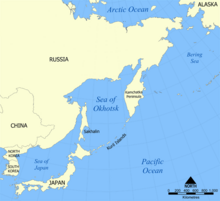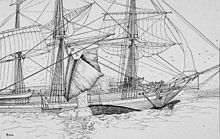North Pacific right whale
E. japonica is easily distinguished from other North Pacific whale species by several fieldmarks: lack of dorsal fin or bump, very broad, black back, cyamid-covered callosities on the head and lips, a very arched jaw line, a very narrow rostrum, and often a V-shaped spout.
Between 2000 and 2006 NOAA researchers deployed passive acoustic listening devices in the Bering Sea and Gulf of Alaska and recorded at least 3,600 North Pacific right whale calls .
[39] They have been seen to enter into ports,[40] staying just next to piers or wharfs,[41][42] and there have been regular records of whales being entangled in set nets along Japanese and South Korean coasts[39] in recent years.
[citation needed] Most recent sightings and acoustic records of right whales in the eastern part of their range have come from a relatively small area in the southeastern Bering Sea.
[34] A 2015 review of the status of all the baleen whales concluded that genetic and photo-ID mark-recapture analyses each suggest there are only about 30 animals left in the eastern subpopulation, mainly observed in the southeastern Bering Sea and with a male bias to the population.
The 2015 reviewers concluded that all data collected since 1992 in the western North Pacific, especially the Sea of Okhotsk, need to be analyzed for a new abundance estimate so that an assessment can be completed for this subpopulation.
[11] In August 2015, NOAA Fisheries conducted a three-week dedicated ship survey for North Pacific right whales in the Gulf of Alaska southeast of Kodiak Island [2] covering 2,500 nautical miles with both visual observers and acoustic detection devices (sonobuoys).
[34] A proposed oil and gas lease of North Aleutian Basin in the SE Bering Sea caused the Minerals Management Service (MMS) of the Department of the Interior to fund at an annual cost of about $1 million a cooperative series of annual surveys with the National Marine Fisheries Service and the North Pacific Research Board (NPRB), with a focus on located right whales and gathering further information about them.
Pelagic waters off southeastern Kamchatka Peninsula is the location possibly with the highest sighting frequency in recent years even though this area is far offshore and it is unclear where these whales migrate southward.
Off the west coast of the United States, Point Conception is a turning location in terms of sighting records in the 19th and 20th centuries,[100] and this may contribute to support the once-abandoned idea; existence of historical breeding grounds in coastal waters including along North American continent.
In Asia, southernmost of areas with higher catch densities were the pelagic waters between continental China (latitudes equal to Shanghai and Zhoushan Islands) and west of Kyushu in south to southern coasts of Korean Peninsula during the summer.
[172] Reviewing of other Eubalaena species' biology, as the population of E. australis in New Zealand primarily use subantarctic Auckland and Campbell Islands as wintering/calving grounds, and the majority of non-calving adults of E. glacialis winter in pelagic waters of Bay of Fundy with recent records of new-born calves present in the region.
These areas are known to be feasible for feeding/summering; hence, it is possible that it is not always necessarily for right whales in North Pacific to migrate to warmer waters for wintering/calving, and historical wintering ranges could have been much broader than previously considered.
Off the west coast of the United States, Point Conception is a turning location in terms of sighting records in the 19th and 20th centuries,[100] and this may contribute to support the once-abandoned idea; existence of historical breeding grounds in coastal waters including along North American continent.
There are remote (hence less pressures from impacts of human activities) and unstudied areas still possessing less – damaged environments where right whales were historically distributed, scattering among North Pacific and adjacent waters.
According to other Eubalaena species' seasonal distribution, some proportions of Pacific right whales could winter in colder waters, and congregation areas could also be restricted into particular harbors or straits of particular oceanic islands.
In adopting a Recovery Plan for the North Pacific right whale, the United States government (NOAA) described its evaluation of the various threats to the continued survival of the species.
As the NMFS Status Review notes: "Zooplankton abundance and density in the Bering Sea has been shown to be highly variable, affected by climate, weather, and ocean processes and in particular ice extent.
In its 2006 Status Review, NMFS notes that the development of the Russian oil fields off the Sakhalin Islands in the Sea of Okhotsk "is occurring within the habitat" of the western population of North Pacific right whales.
In its 2006 Status Review, NMFS concludes: "In general, the impact of noise from shipping or industrial activities on the communication, behavior and distribution of right whales remains unknown.
"[11] On April 8, 2008, a NMFS review found that there had been no recent Outer Continental Shelf oil and gas activities in or adjacent to the areas designated as critical habitat for E.
[192] On March 31, 2010, President Obama issued a memorandum for the Secretary of the Interior withdrawing Sale 214 from disposition by leasing through June 30, 2017, the Bristol Bay area of the North Aleutian Basin in Alaska.
In its 2013 evaluation of the threats to survival of the North Pacific right whale, NOAA examined the possible impacts of entanglement in fishing gear and ingestion of marine debris.
The U.S. National Marine Fisheries Service reports "currently there is no funding at all for North Pacific right whale research despite the critically endangered nature of this population.
In the western portion of their range, the ability of researchers to find right whales in the Sea of Okhotsk and Kuril Islands is greatly hindered by the difficulty and expense of getting access to these areas which are in Russian territorial waters and EEZ, and by the fog that makes visibility minimal.
Second, the Marine Mammal Protection Act (MMPA) gives jurisdiction for management of all whale species to the National Oceanic and Atmospheric Administration (NOAA) of the Department of Commerce.
The Endangered Species Act directs the managing agencies, in this case NOAA, to designate portions of oceans as "Critical Habitat" which triggers specific protective measures.
NMFS also ruled that the zooplankton PCE was vulnerable to oil spills and discharges, which may require measures such as conditioning federal permits or authorizations with special operational constraints.
Acoustic moorings detected North Pacific right whale calls across all years and seasons from 2009 to 2015 in Unimak Pass in the Aleutian Islands, which is not currently designated critical habitat.
[54] In 1977, one of a pair firstly sighted at beaches in Numadu was driven into port of Kumomi next day and was killed[250] (although majority of medias even the museum itself claim that people tried their best to save the whale who stranded him/herself).

















